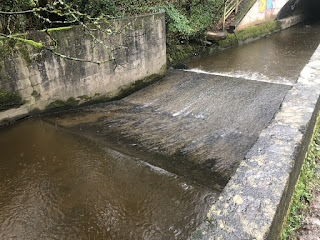27/01/2022 Kick Sampling at Smithy Brook
 |
| Sarcoscypha coccinea |
Mark has plans to install a series of leaky dams along
Smithy Brook. Leaky dams allow the regular flow of water to pass through
uninterrupted but slow and divert large swells of water caused by heavy rain
pour. They are great at maintaining and regulating flow whilst minimally
interfering with natural processes such as fish migration. Once the
installation of the new leaky dams is underway I will write an update post and
explain more about leaky dams and their effectiveness.
 |
| Leaky dam in full effect-Image borrowed from Yorkshire Dales Rivers Trust Facebook page |
How to Kick Sample
Kick sampling is a crucial technique in determining the
quality of water. Water can look crystal clear yet be of poor quality for
sustaining life. Meanwhile, it can look murky but offer excellent conditions and be
very hospitable. Kick sampling provides a great way to check the quality of
water. It entails collecting a sample from the water and checking what life is
present. You will often uncover invertebrates, but
occasionally you'll be lucky enough to find a small fish. The type of collected species can suggest water quality as each has varying
levels of sensitivity towards the chemicals and nutrients present in the
waterbody.
Taking a kick sample is an essentially simple process – a primary reason why it holds such significant value in citizen science and volunteer monitoring. It only requires two essential pieces of equipment: a hand net and a bucket/tray. However, you may want to bring containers to separate individual species from the sample. In addition, an ID book also helps to have on-site, and waders help keep dry if you're in deeper areas of water.
The technique is simple:
1) Fill the bucket/tray about halfway up with river
water
2) Find a suitable patch to take the sample
 |
| Smithy Brook |
3) Place your net about two feet behind your feet
downstream in the water
4) Disturb the earth beneath your feet for a set
amount of time (3 minutes is standard)
5) Empty your net into your bucket or tray
6) Sort through and record the species that you
have collected
It is recommendable to take a sample every month to establish any changes and patterns in a particular area. The species of invertebrates found are a great indicator of the water's quality. Invertebrates can be rated to indicate water quality. For example, Asellus Aquaticus, commonly known as a water louse, are extremely good at surviving in harsh conditions, so it would not indicate a high quality of water. Meanwhile, the Lepidostoma Hirtum larvae, a caddisfly species, are more sensitive and require a higher quality for survival, indicating a healthier body of water.
 |
| Asellus Aquaticus (Left) and Lepidostoma Hirtum (Right) |
Ecocide
However, our kick sampling along Smithy Brook
revealed evidence of a catastrophic polluting event, referred to by Ian Parker,
a local landowner and founder of the River Douglas Association, as an 'ecocide'. The brook was coated in a
layer of dead Gammarus pulex, a common freshwater shrimp, and
our samples only revealed the further extent of damage that had been dealt.
Almost every species of invertebrate collected was dead. It appeared the only
specimens collected that still exhibited signs of life were the more robust
species: sewage worms, leech, flatworm and water lice. And even a lot of them
had already perished.
 |
| Kick sample containing large amounts of dead Gammarus |
Samuel and Mark had been at the brook only a week before conducting kick sampling. In hindsight, Samuel notes that there were many dead Baetis Nymphs (immature olive mayfly) and that the population of Gammarus appeared to be struggling. A week later, by the time we took our most recent samples, the Baetis had vanished entirely and only dead Gammarus remained. The pollution event appeared to take out the most vulnerable first, systematically killing off species in order of sensitivity towards high P.H and ammonia levels.
Along with Ian, we were joined by Paul Kenyon, a landowner and founder of the River Douglas Association, and Duncan Ashcroft, the owner and author of the Environment Times. While collecting kick samples, Ian, Paul and Duncan split off and explored further upstream. Eventually, they came to the source of the pollution over a mile from where they left us. They reported that P.H levels came in at 8+ across this entire mile-long stretch, suggesting the contamination to be seriously damaging.
Only metres upstream from the toxic outfall, they reported healthy waters that were teeming with plenty of healthy Gammarus. They even spotted some stickleback fish. This strongly suggests the outfall they located to be the source of all the carnage downstream. The incident and suspected source of pollution have been reported to the Environmental Agency. However, such a catastrophic incident will most likely require a lengthy recovery period. We can expect to see a lack of bio-diversity in the waters of Smithy Brook over the months to come.







Comments
Post a Comment